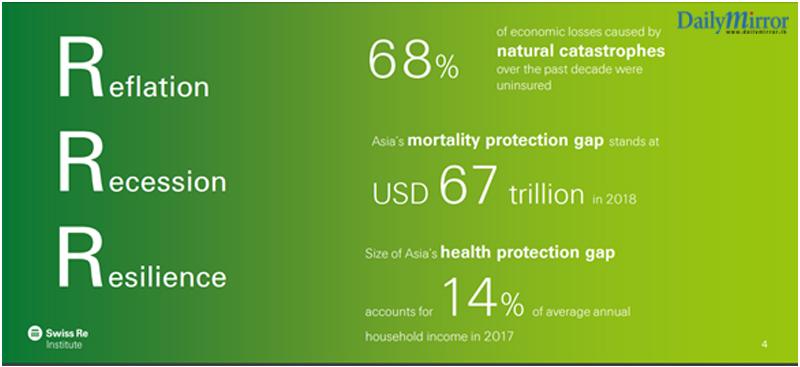
With the conclusion of Insurance Awareness Month Mr. Chandana Aluthgama, the Treasurer of the Insurance Association of Sri Lanka, one of the leading bodies behind the organization of the events, programs and activations that make up the month of September, discussed his views on several aspects of the industry including penetration, value, recruitment and challenges.
1. What is the role of IFRS 17?
IFRS 17 is an International Financial Reporting Standard that was issued by the International Accounting Standards Board in May 2017. Under the IFRS 17 model, insurance contract liabilities will be calculated as the present value of future insurance cash flows with a provision for risk.
The new insurance contracts standard, IFRS 17, aims to increase transparency and to reduce diversity in the accounting for insurance contracts.
The changes could significantly affect the insurance industry in profitability patterns, volatility of financial results and equity, and the level of transparency about profit drivers and equity levels.
Ex: How does IFRS 17 define an insurance contract?
An insurance contract is a contract under which one party – the issuer – accepts “significant insurance risk” from another party – the policyholder.
As per IFRS 17 concerns, the issuer agrees to compensate the policyholder “in the face of a specified uncertain future event- the insured event – adversely affects the policyholder”.
2. The current level of insurance penetration in the country?
Overall – 1.24% (Insurance Premium as a percentage of GDP)
Life – 0.54%
Non- Life – 0.70%
Data – As at 2018 (IRCSL Annual Report)
3. The need for insurance and risks that threaten the uninsured?
4. Why do people not buy insurance, could affordability be one of the reasons and what can the insurance industry do about it?
PRICE
One barrier to buying insurance is the price. Many consider it too expensive in the face of more pressing needs in their current budget. Paying for the basics (e.g., housing, food, utilities) takes priority over life insurance; some value over end of life expenses.
MISUNDERSTANDING
Many people have incorrect information on what coverage would actually cost. Young adults assume a much higher price than those who are older. That said, the costs tend to be only a couple of hundred dollars in difference in terms of life insurance.
PRIORITIES
When faced with decisions about purchasing life insurance, many opt to save for retirement first. Others choose to prepare for a premature death, to plan for the funeral, or determine the disposition of their estate.
CULTURE
Culture plays a major role when it comes to decision making of unsought nature of a product category such as insurance. People purchase insurance because they see it as a mandatory need in the face of any negative outcomes in life. Still a majority of the Sri Lankan society and family units are dependable on each other. People do not focus much on risk management, risk transferring mechanisms and the need of covering protection gap in terms of life and health. This has been further caused due to the fact we take these risks for granted. People tend to spend for many unnecessary goods and services in their day to day life, while keeping insurance as the last option.
DEMANDS
For many, thoughts of life insurance don’t enter their minds until after they’ve had kids, a time when every decision begins to be taken more seriously. However, the increased costs that come with having children may mean that life insurance takes second place again.
DIFFICULTY
Limited understanding and pressing obligations leave people paralyzed, thus they make no choice. Trying to decide whether they should get term life insurance, permanent life insurance, or one of the numerous variations can leave them in a quandary Most people have no idea how much life insurance they might need, let alone decide on which type to get.
DISTRUST
Insurance companies do not enjoy a great reputation. This lack of trust has the potential to put people off the idea of acquiring life insurance.
DISCOMFORT
When asked to think about end of life planning, many people choose to do nothing because such thoughts make them uncomfortable. For some, trying to decide what type of life insurance they should buy falls into the same category and provokes the same feeling of discomfort, meaning people just won’t do it.
GOOD HEALTH
Those who are young tend to see themselves as healthier and more fit, and enjoy a sense of indestructibility, as death seems so far away. They fail to realize that being young and healthy makes them more likely to get better life insurance, whereas aging and other health problems that may arise later make it harder.
NO NEED
Some people won’t buy life insurance because they don’t have dependents. When you’re young, you’re likely to make less money, but you’re also less likely to have as many demands on your earnings. If you decide to prioritize the expense then, you become used to it and make financial decisions with it already priced in.
5. What challenges come in the way of recruitment in the insurance industry and what solutions would you suggest to counter these issues?
• Selecting the right people in terms of attitude, knowledge, competency and capabilities
• Knowledge gaps between academic exposure and industry applications
• Specializing in a specific area and narrowing down one’s approach when it comes to working in multi- discipline areas rather multi –tasking roles. Ex: Underwriter vs Claims officer etc…
• Lack of open innovation culture and due to this, the industry doesn’t attract much talent from generation Z and segments of the millennials generations.
• Industry inherent culture is not in the position to compete with companies with open innovation culture such as Telco, Digitech and Fintech firms. Open innovation culture would offer much more benefits than the insurance industry due to its business structure and model.
Ex: flexible working patterns, the open door approach, innovation and critical thinking etc.
Solutions to counter the above drawbacks/challenges
• Closely work with academic institutions and universities in order to update and streamline the courses and academic qualifications, which should be aligned to modern industry practices.
• Much more involvement and contribution towards career guidance and professional orientation projects.
• Encourage open innovation culture within the industry.
• Re-define the business structures in order to attract talent pool rather lose heads.
• Encourage and attract multi–discipline and multi-tasking business structures, processes and models.
6. What is the ideal methodology to follow in order to ensure employee retention?
• Sustainable business succession plan
• Acceptance of Human Capital Development as a strategic approach rather than an operational process.
• Encourage performance driven culture within the industry
• Establish code of conduct and encourage ethical practices when it comes to headhunting
 With the conclusion of Insurance Awareness Month Mr. Chandana Aluthgama, the Treasurer of the Insurance Association of Sri Lanka, one of the leading bodies behind the organization of the events, programs and activations that make up the month of September, discussed his views on several aspects of the industry including penetration, value, recruitment and challenges.
With the conclusion of Insurance Awareness Month Mr. Chandana Aluthgama, the Treasurer of the Insurance Association of Sri Lanka, one of the leading bodies behind the organization of the events, programs and activations that make up the month of September, discussed his views on several aspects of the industry including penetration, value, recruitment and challenges.